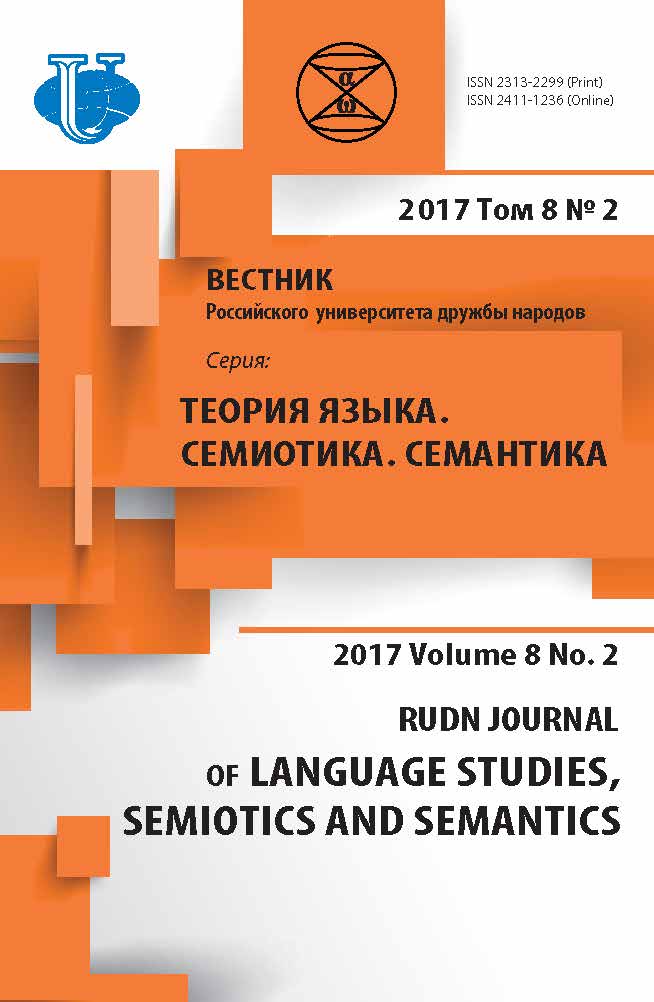Linguistic Means of Russia’s Image Making in Modern Advertising
- Authors: Remchukova E.N.1, Omelianenko V.A.1
-
Affiliations:
- RUDN University
- Issue: Vol 8, No 2 (2017)
- Pages: 341-349
- Section: Articles
- URL: https://journals.rudn.ru/semiotics-semantics/article/view/16343
- DOI: https://doi.org/10.22363/2313-2299-2017-8-2-341-349
Cite item
Full Text
Abstract
The article is devoted to description of the linguistic features specific means of Russia’s image making in modern TV advertising. Linguistic issue of the image is to study the concept, distinguish it from certain closely related concepts and also to use a variety of linguistic means of influence on the mass audience which involved in the formation of the country’s image. The article used the traditional descriptive method based on direct observation of the linguistic material. From this point of view well-formed Russia’s image will help to strengthen its world position. Positive image created in the media fixed and stereotyped in advertising. Specificity of advertising of domestic products is the use of traditional language resources like phraseology, folklore, metaphors, etc.
About the authors
Elena Nikolaevna Remchukova
RUDN University
Author for correspondence.
Email: remchukova@pochta.ru
10/2, Miklukho-Maklaya st., Moscow, Russia, 117198
Victoria Aleksandrovna Omelianenko
RUDN University
Email: omelianenko_va@pfur.ru
10/2, Miklukho-Maklaya st., Moscow, Russia, 117198
References
- Kondratov, S.A. (Ed.). (2006). A large encyclopedia in 62 volumes. Moscow: TERRA. (in Russ).
- Kuznetsov, S.A. (Ed.). (2000). Big Dictionary of the Russian Language. St. Petersburg: Norint. (in Russ).
- Bulygina, T.V. & Shmeljov, A.D. (1997) Language conceptualization of the world (based on Russian grammar). Moscow: School of Languages of Russian Culture. (in Russ).
- Bykova, Yu.N. (2012). Language tools for the formation of a modern Russian journalist on the example of information and information-analytical programs [dissertation] Tver State University. Tver. (in Russ).
- Vasjukova, I.A. (1998). Dictionary of foreign words. Moscow: AST-PRESS. (in Russ).
- Vezhbicka, A. (1996). Semantics, Culture and Cognition. Translation from English. Executive editor M.A. Cronhaus. Moscow: Russian dictionaries. (in Russ).
- Galumov, Je.A. (2003). International image of Russia: formation strategies. Moscow: Izvestia. (in Russ).
- Grinjov, I.V. (2009). The role of the national Russian culture in shaping the country’s international image [dissertation] State University of Management. Moscow. (in Russ).
- Zirka, V.V. (2005). Linguistic Paradigm of Manipulative Play in Advertising. Dnepropetrovsk. (in Russ).
- Vasilenko, I.A. (2016). Image of Russian regions: innovative technologies and rebranding strategies. Moscow: International Relations. (in Russ).
- Kubryakova, E.S. (2008). To the defenition of the notion “image”. Issues of cognitive Linguistics, 1(014), 5—11.
- Krysin, L.P. (2005). Explanatory Dictionary of Foreign Words. Moscow: Russian language. (in Russ).
- Medvedeva, E.V. (2008). Advertising Communication. Moscow: Publishing house LKI. (in Russ).
- Martynova, L.G. (2011). The modern image of Russia: problems and prospects. [Dissertation]. The Russian Presidential Academy of National Economy and Public Administration). Moscow. (in Russ).
- Morozov, A.Yu. (2012). Image in Advertising A Linguistic Study. Samara: Ofort. (in Russ).
- Pristayko, T.S. (2010). On the stylish iPOD’e utter the word (Evaluation vocabulary in advertising high-tech products). Bulletin of Dnepropetrovsk University Вісн. Дніпропетров. ун-ту: Linguistics series, 16.
- Prohorov, A.V. (2013). Lingua-cognitive peculiarities of image modeling. Tambov University Reports. Series: Humanities, 9(125), 254—257. (in Russ).
- Minaeva, L.V. (Ed). (2002). Speech communication in modern society. Moscow: National Association of Teachers of English in Russia.
- Remchukova, E.N. & Omelianenko, V.A. (2015). Combinatorics in an Advertising Headline as a Way to Achieve Hyper-Expressivity (a case study of Russian-language specialized magazines in Ukraine). Scientific Journal Medi@lmanah, 5(70), 62—69. (in Russ).
- Remchukova, E.N. & Strahova, A.V. (2016). Advertising “behind the looking glass” of Russia and France: Lingvocreative and gender aspects. Moscow: LENAND. (in Russ).
- Rozhkov, I.Ya. & Kismereshkin, V.G. (2008). Image of Russia. Resources. An experience. Priorities. Moscow: Ripol Classic. (in Russ).
- Stepanov, Yu.S. (1997). Constants. Dictionary of Russian Culture. Moscow: Languages of Russian culture.
- Terskih, M.V. & Maljonova, E.D. (2015). Media form of the Siberian region: linguocognitive modeling. Omsk: LITERA. (in Russ).
- Shevchenko, L.I., Dergach, D.V. & Sizonov, D.Ju. (2014). Medialinguistics. Dictionary of terms and concepts. Kyiv: publishing and printing center “Kyiv University”.
- Chulkina, N.L. & Gomes Dias, V.В. (2016). The Ambivalence of the Concept of Yurodstvo/ Yurodivyi within the Russian Linguistic World-Image. Journal of Psycholinguistics, 2(28), 291—301. (in Russ).
- Falla, P. (Ed.) (1984). The Oxford English-Russian Dictionary Oxford. New York. Oxford University Press.













